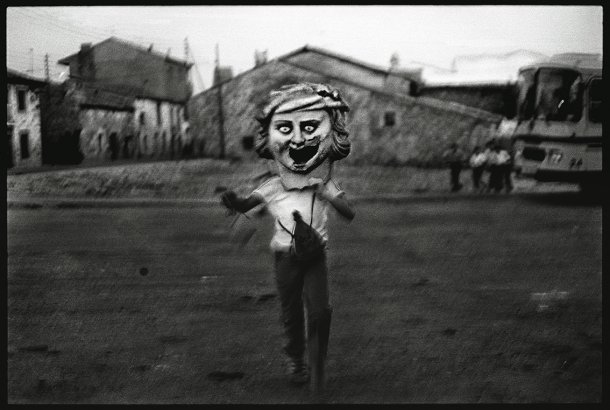MADRID, SPAIN. A man stands on the streets of an old village holding a mask over his head. What may look like the cover of a horror film, Hara captivates viewers and pulls them in for their own personal interpretation.
With the perfect blend of eeriness and mystery, this photograph captures a simplistic backdrop to an eccentric focal point, the man with the mask. The man and his mask brings an overall dark, grim atmosphere to what otherwise may have been just an average Spanish village.
However, one can look at this photograph in various other ways as well. Perhaps the mask provides a whimsical, innocent element.
What gravitated me towards this photo is its strangeness and uniqueness. I love the idea of magic realism used. Magic realism can be placed in literature, film, or any visual arts. The concept is that shocking elements are incorporated into a realistic, ordinary setting. Therefore, objects or scenes that may fit your typical, everyday life are suddenly highlighted in such ways that the conventional rules of our “real world” are broken.
A central object as simple as this mask can leave so much to the viewer’s imagination.
In photo exhibition, Tan Lejos, Tan Cerca, documentary-style photography is explored in various rural villages of Spain, during the 1970s. The works of art showcase the simpler realities that a provincial, small-town lifestyle can offer, which serve as a stark contrast to the outsider’s idealistic, romantic perception of Spanish urban life at the time.
With the use of magic realism and poignant imagery in an otherwise mundane or serious scene, the photos highlighted the realistic, simplistic truths that lie at the core of our being.
It is a combination of happiness, sadness, failures, and success that essentially make all of us who we are. Without these events or imperfections, we aren’t human.
Upon viewing this exhibition, I came to the realization that it’s the most basic things in everyday life that seem to go unnoticed. Even the title of this exhibition is a perfect way to describe how we tend to get so caught up in our busy routines or daily stresses, that the simple joys seem so far away, when really they are so close and tangible.
In the above photo, Cristóbal Hara displays the significance of the mask that covers the man. Who is the man behind it? Would we really stop to look at this photo without the added prop?
If we take off our masks; if we strip away the materialistic things that we believe we need, the money we must earn, the totem pole we must climb up, we humans at our core, are basic.
Do added props and possessions define who we are?

